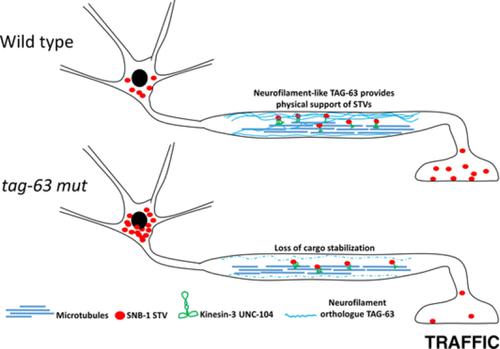Our official English website, www.x-mol.net, welcomes your
feedback! (Note: you will need to create a separate account there.)
Characterization of TAG-63 and its role on axonal transport in C. elegans.
Traffic ( IF 3.6 ) Pub Date : 2019-10-17 , DOI: 10.1111/tra.12706 Prerana Bhan,Muniesh Muthaiyan Shanmugam,Ding Wang,Odvogmed Bayansan,Chih-Wei Chen,Oliver I Wagner
Traffic ( IF 3.6 ) Pub Date : 2019-10-17 , DOI: 10.1111/tra.12706 Prerana Bhan,Muniesh Muthaiyan Shanmugam,Ding Wang,Odvogmed Bayansan,Chih-Wei Chen,Oliver I Wagner

|
Model organisms are increasingly used to study and understand how neurofilament (NF)-based neurological diseases develop. However, whether a NF homolog exists in C. elegans remains unclear. We characterize TAG-63 as a NF-like protein with sequence homologies to human NEFH carrying various coiled coils as well as clustered phosphorylation sites. TAG-63 also exhibits features of NFL such as a molecular weight of around 70 kD, the lack of KSP repeats and the ability to form 10 nm filamentous structures in transmission electron micrographs. An anti-NEFH antibody detects a band at the predicted molecular weight of TAG-63 in Western blots of whole worm lysates and this band cannot be detected in tag-63 knockout worms. A transcriptional tag-63 reporter expresses in a broad range of neurons, and various anti-NFH antibodies stain worm neurons with an overlapping expression of axonal vesicle transporter UNC-104(KIF1A). Cultured neurons grow shorter axons when incubating with drugs known to disintegrate the NF network and rhodamine-labeled in vitro reconstituted TAG-63 filaments disintegrate upon drug exposure. Speeds of UNC-104 motors are diminished in tag-63 mutant worms with visibly increased accumulations of motors along axons. UNC-104/TAG-63 and SNB-1/TAG-63 not only colocalize in neurons but also revealed positive BiFC (bimolecular fluorescence assay) signals. In summary, we identified and characterized TAG-63 in C. elegans, and demonstrate that lack of this protein limits axonal transport efficiencies. Additionally, this study would aid in developing NF-related disease models in the future.
更新日期:2020-01-21











































 京公网安备 11010802027423号
京公网安备 11010802027423号